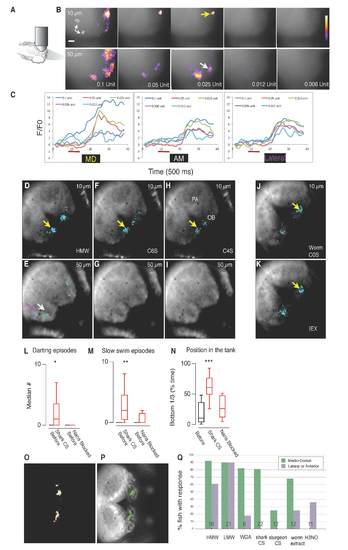- Title
-
Chondroitin fragments are odorants that trigger fear behavior in fish
- Authors
- Mathuru, A.S., Kibat, C., Cheong, W.F., Shui, G., Wenk, M.R., Friedrich, R.W., and Jesuthasan, S.
- Source
- Full text @ Curr. Biol.
|
Olfactory Bulb Response to Skin Extract and Purified Chondroitin Sulfate (A-F) Increase in calcium in the mediodorsal (yellow arrow), anterior (white arrow) and lateral (magenta arrow) olfactory bulb, in response to stimulation of the olfactory epithelium with the active fraction of skin extract obtained by ion exchange chromatography. (A and B) Dorsal view of the olfactory bulb, at two different focal planes as indicated by the numbers on the top right of each panel. (C-E) Positions of the active loci, in frontal views generated from deconvolved z stacks at the level of arrows. (F-K) Activity in the left olfactory bulb of a 25-day-old fish, in response to HMW, LMW, and eluate from the WGA column. The images here show a dorsal view of the left bulb, at two different focal planes. (L-S) Response in the bulb at two different focal planes in another fish, following stimulation with partially purified skin extract (L and P), chondroitin sulfate purified from shark cartilage (M and Q), H3NO (N and R), and glycocholic acid (O and S; red arrow). The asterisk in (L) indicates a signal in the pallium. OE, olfactory epithelium; OB, olfactory bulb; Pa, pallium; IEX, active fraction from ion exchange column; d, dorsal; v, ventral; m, medial; l, lateral. Scale bar represents 50 µm; anterior is to the right in all cases. The wedge in (A) shows the look-up table used for ratio images. An intensity-modulated look-up table is used, with grays representing a ratio of 1 and yellows representing a ratio of 2.5. See also Figure S3. |
|
Olfactory Responses to Schresckstoff Components (A) A 3 to 5 weeks old fish, with odorant directed towards the olfactory pits while the brain is imaged from above. (B) Calcium increase in the OB following stimulation with different amounts (2-fold dilutions, starting at 0.1 units) of the active fraction from the anion-exchange column in the medio-dorsal (yellow arrow) anterio-medial (white) and lateral (magenta) at two planes (relative position in um indicated on the panels). (C) Temporal responses at these loci after stimulus (red bar) to different concentrations (see legend). (D-I) Response in the bulb at two different focal planes, following stimulation with HMW (D, E), C6S purified from shark cartilage (F, G), C4S purified from sturgeon. (J, K) Response in the bulb at one plane to C0S purified from Caenorhabditis elegans, and active fraction from anion exchange clolumn (IEX) in a different fish (relative position in um indicated on the panels). (L-N) Median number of darting (L), slow swim episodes (M) and position in tank to Shark CS after blocking the naris using a tissue adhesive (n=5). Shark CS responses plotted from Fig. 4 for comparison. (O, P) Overlap of calcium signal elicited by IEX and shark CS (see Figure 5L, M). The region of overlap is shown in white in panel O; red indicates fluorescence from IEX and green from shark CS. (P) The region of overlap (green) overlaid on an image of GCaMP2 fluorescence from that plane. (Q) Percentage of fish with a calcium response in the olfactory bulb to the specified odorant. The number of fish analyzed is indicated |


